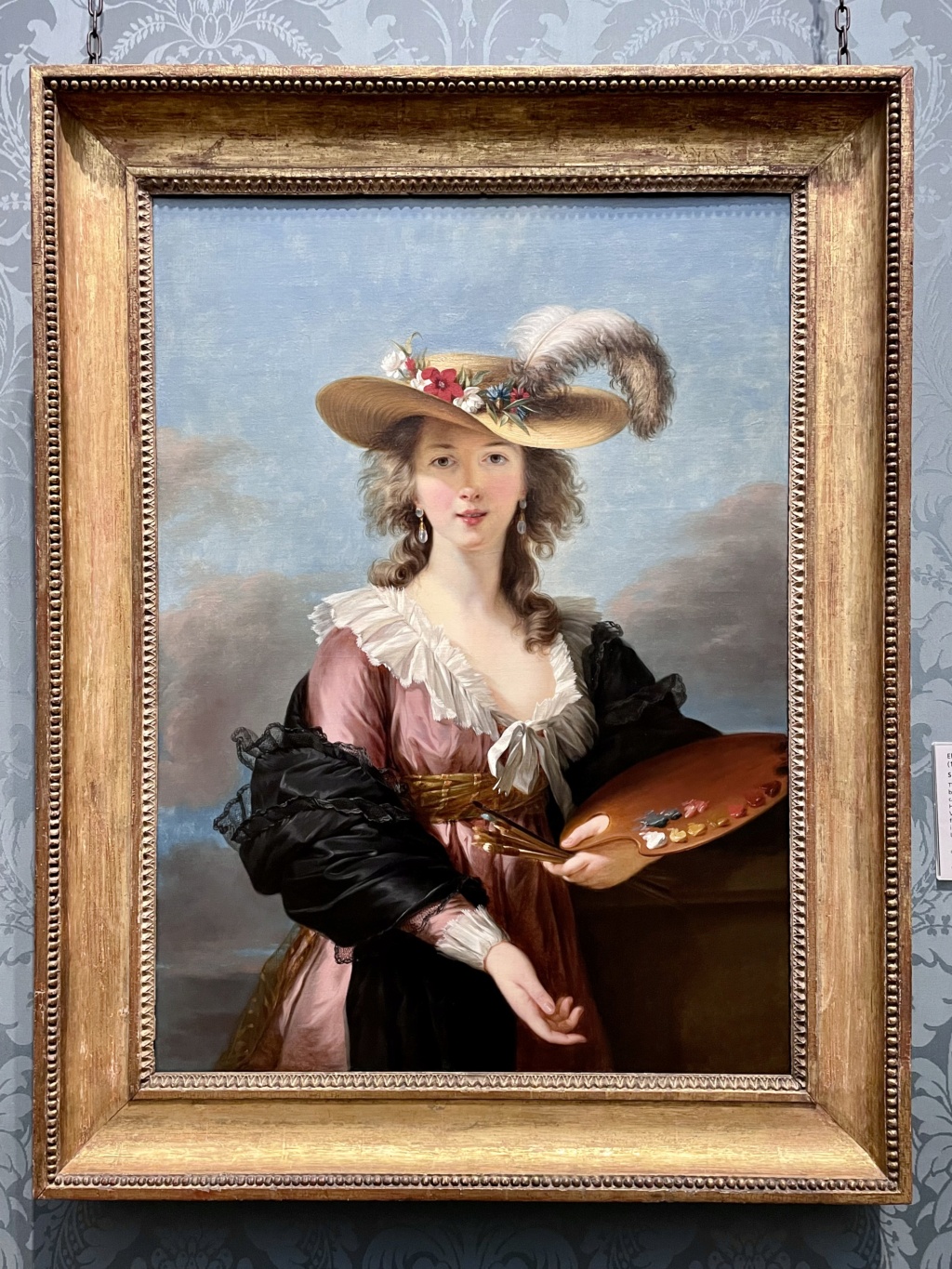Les autoportraits de Mme Vigée Le Brun
+5
Mr de Talaru
Trianon
Mme de Sabran
Rue Royale
La nuit, la neige
9 participants
LE FORUM DE MARIE-ANTOINETTE :: La France et le Monde au XVIIIe siècle :: Les Arts et l'artisanat au XVIIIe siècle :: Les arts graphiques et la sculpture
Page 3 sur 3
Page 3 sur 3 •  1, 2, 3
1, 2, 3
 Re: Les autoportraits de Mme Vigée Le Brun
Re: Les autoportraits de Mme Vigée Le Brun
Majesté a écrit:
Non, justement ! C'est par hasard que je les ai trouvés sur le net...
Il y a plusieurs versions et variantes de ce portrait sur le net, avec des attributions variées.
Ce qui est sûr c'est qu'il a été repris et copié.
Selon le site Batguano, l'original serait celui-ci : http://www.batguano.com/vigeeart20.html
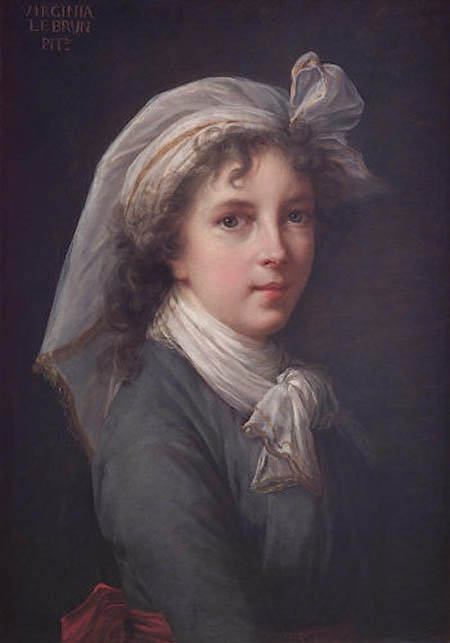
Mais je ne comprends pas la mention "Virginia Lebrun Pit".
Ajoutée postérieurement ?
Il n'y pas de rubrique consacrée aux autoportraits dans le bouquin de la RMN ?!!
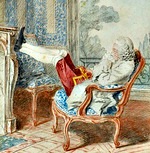
La nuit, la neige- Messages : 18131
Date d'inscription : 21/12/2013
 Re: Les autoportraits de Mme Vigée Le Brun
Re: Les autoportraits de Mme Vigée Le Brun
Si, 4 tableaux et 3 dessins et ailleurs dans le livre 3 autoportraits avec sa fille. Le tableau ci-dessus n'est pas présent.La nuit, la neige a écrit:Il n'y pas de rubrique consacrée aux autoportraits dans le bouquin de la RMN ?!!
Pit ne serait pas le nom du copiste plutôt ?
Olivier, pas Brad

Olivier- Messages : 1007
Date d'inscription : 21/12/2013
 Re: Les autoportraits de Mme Vigée Le Brun
Re: Les autoportraits de Mme Vigée Le Brun
Bon...Merci pour la recherche.Olivier a écrit:
Si, 4 tableaux et 3 dessins et ailleurs dans le livre 3 autoportraits avec sa fille. Le tableau ci-dessus n'est pas présent.
Olivier a écrit:Pit ne serait pas le nom du copiste plutôt ?
Je ne pense pas.
Pit. est, d'après moi, la contraction de Pittore en italien : peintre.
Puisque ce tableau, nous dit le site cité, avait été réalisé pour l'Académie San Luca de Rome, en 1790.
Un peu comme le "Fecit" (fait) que nous voyons parfois sur certains tableaux (conjointement à la signature).
Donc : Virginia Lebrun, peintre.
Je crois avoir déjà vue ailleurs cette mention : Virginia Lebrun.
Mais je ne me rappelle plus où, et je ne la comprends pas ?
Et en tous les cas, ce n'est pas sa signature.
C'est pour cette raison que je supposais que cette mention avait été ajoutée plus tard.
Mystère.

Peut-être l'artiste fait elle mention de ce don dans ses Souvenirs ?
Je n'ai pas regardé.

La nuit, la neige- Messages : 18131
Date d'inscription : 21/12/2013
 Re: Les autoportraits de Mme Vigée Le Brun
Re: Les autoportraits de Mme Vigée Le Brun
Majesté a écrit: En voici deux nouveaux ! :n,,;::::!!!::
Bien à vous.
Merci, ils sont tous les deux très agréables et je ne les connaissais pas. On voit sur le deuxième que la mode a évolué.

Rue Royale- Messages : 13
Date d'inscription : 13/09/2015
Localisation : Dijon
 Re: Les autoportraits de Mme Vigée Le Brun
Re: Les autoportraits de Mme Vigée Le Brun
A l'occasion d'une vente aux enchères, nous avions présenté ce dessin.
C'était au début de ce sujet, ici : https://marie-antoinette.forumactif.org/t2099-les-autoportraits-de-mme-vigee-le-brun
Et nous nous demandions s'il serait présenté à l'exposition Vigée Le Brun (elle n'était alors qu'annoncée)...boudoi32
Eh bien, il y était !
Le voici....

C'était au début de ce sujet, ici : https://marie-antoinette.forumactif.org/t2099-les-autoportraits-de-mme-vigee-le-brun
Et nous nous demandions s'il serait présenté à l'exposition Vigée Le Brun (elle n'était alors qu'annoncée)...boudoi32
Majesté a écrit:Merci pour cette mise à jour !
J'espère aussi retrouver ce genre de dessins préparatoires.
Eh bien, il y était !

Le voici....


La nuit, la neige- Messages : 18131
Date d'inscription : 21/12/2013
 Re: Les autoportraits de Mme Vigée Le Brun
Re: Les autoportraits de Mme Vigée Le Brun
Je lui ai trouvé le cou trop long ... 
Cela me frappe à nouveau sur ta photo ( dis donc, elles sont très bonnes tes photos ! )
)
Mais le visage est tellement adorable !

Cela me frappe à nouveau sur ta photo ( dis donc, elles sont très bonnes tes photos !
Mais le visage est tellement adorable !
_________________
... demain est un autre jour .

Mme de Sabran- Messages : 55497
Date d'inscription : 21/12/2013
Localisation : l'Ouest sauvage
 Re: Les autoportraits de Mme Vigée Le Brun
Re: Les autoportraits de Mme Vigée Le Brun
J'en poste quelques-unes avant le retour d'Olivier (futur grand reporter photo du Forum) car, dès lors, je n'aurai plus qu'à passer la main à bien meilleur que moi... :Mme de Sabran a écrit:dis donc, elles sont très bonnes tes photos !


La nuit, la neige- Messages : 18131
Date d'inscription : 21/12/2013
 Portraits de Mme Le Brun avec sa fille
Portraits de Mme Le Brun avec sa fille
Figure d'artiste était une exposition initialement programmée jusqu'au 29 juin, dans la Petite Galerie du musée du Louvre.
Elle a tôt fermé fermé ses portes, au mois mars, mais se découvre dans le cadre d'une visite virtuelle sur le site du musée, ici : Petite Galerie, musée du Louvre
Vous y retrouverez l'un des autoportraits de l'artiste accompagnée de sa fille, accompagné de cette courte présentation :
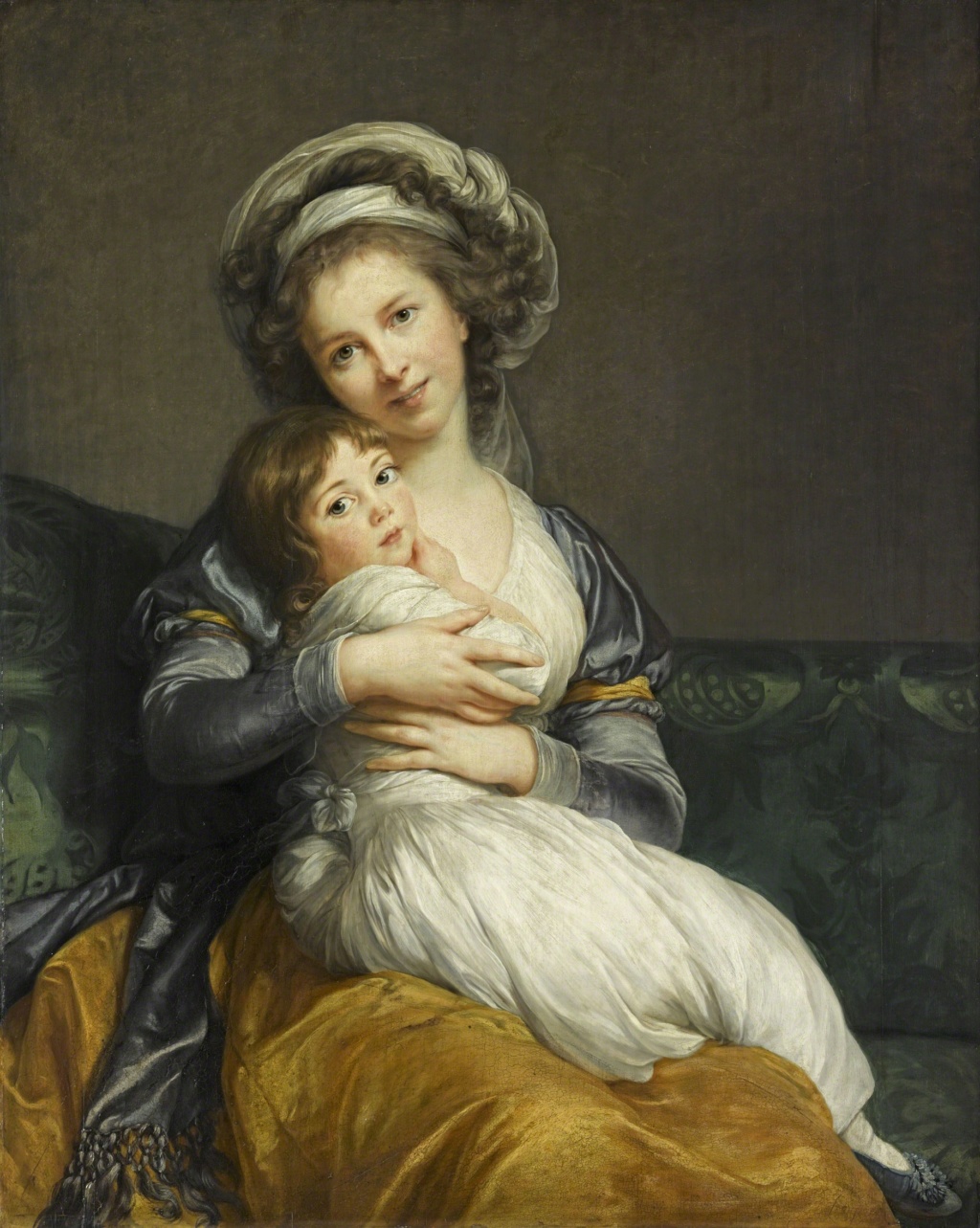
Mme Vigée Le Brun et sa fille
Elisabeth-Louise Vigée Le Brun
Huile sur bois, 1786
Musée du Louvre
Image : RMN - Grand Palais (Musée du Louvre) / Franck Raux
Madame Vigée Le Brun et sa fille
Elisabeth-Louise Vigée Le Brun réalise cet autoportrait en compagnie de sa fille âgée de six ans en 1786, sujet qu’elle reprend en 1789 (Paris musée du Louvre, INV 3068).
L’artiste se représente, enlaçant Jeanne-Lucie dans un geste de protection et de tendresse maternelle, que le spectateur est invité, par le regard de l’enfant, à contempler. Si la scène relève de la sphère privée et de l’intime, elle s’inscrit dans le contexte de valorisation de l’enfant propre au 18e siècle. Jean-Jacques Rousseau a fait paraître L’Emile en 1762.
Au-delà de ses qualités à exprimer les sentiments, madame Vigée Le Brun s’affirme comme une artiste cultivée, s’inspirant dans son œuvre de l’attitude des Vierges à l’Enfant du peintre Raphaël (1483-1520), un des grands maîtres de la Renaissance italienne.
En choisissant d’exposer son autoportrait au Salon de 1787, elle montre ainsi son talent de portraitiste alors que les artistes femmes sont le plus souvent cantonnées dans le genre mineur de la nature morte. Elisabeth-Louise Vigée Le Brun fit une carrière remarquable : reçue académicienne en 1783, portraitiste de la reine Marie-Antoinette (1774-1793), son succès lui permit de s’émanciper de la tutelle masculine et de vivre de son art.

(…) elle s’est peinte tenant sa fille dans ses bras. La sérénité repose sur son front, la joie brille en ses yeux : elle triomphe de porter un si précieux fardeau et rend à son enfant tous les sourires qu’elle en reçoit. Une mignardise que réprouve également et les artistes et les amateurs et les gens de goût, dont il n’y a point d’exemple chez les anciens, c’est qu’en riant elle montre les dents, cette affectation est surtout déplacée dans une mère : elle ne compasse point de la sorte ses mouvements et se livre sans mesure à tout l’excès de son tendre enthousiasme *.
* Barthélemy Mouffle D’Angerville, Lettre I sur le Salon de 1787, dans Bachaumont, Les Salons de Bachaumont , Fabrice Faré ( ed), Paris, Librairie des Arts et métiers, 1995
* Source texte : Petite Galerie du musée du Louvre
Davantage d'informations sur le site internet L'Histoire par l'image qui précise, notamment :
En 1786, Élisabeth Louise Vigée Le Brun réalise un autoportrait avec sa fille, exposé au Salon de 1787. Le tableau touche à ce point le public par la véracité des sentiments représentés qu’il est rapidement surnommé La Tendresse maternelle.
Dans le sillage de ce succès et à la demande du comte d’Angiviller, directeur général des Bâtiments du Roi, l’artiste peint en 1789 une variante en costume grec tout aussi réputée.
 La suite est à lire ici : Le nouveau visage de l'amour maternel (L'Histoire par l'image)
La suite est à lire ici : Le nouveau visage de l'amour maternel (L'Histoire par l'image)
 Et voici la toute aussi la toute aussi célèbre variante en costume grec, peinte trois ans plus tard, également conservée au musée du Louvre :
Et voici la toute aussi la toute aussi célèbre variante en costume grec, peinte trois ans plus tard, également conservée au musée du Louvre :
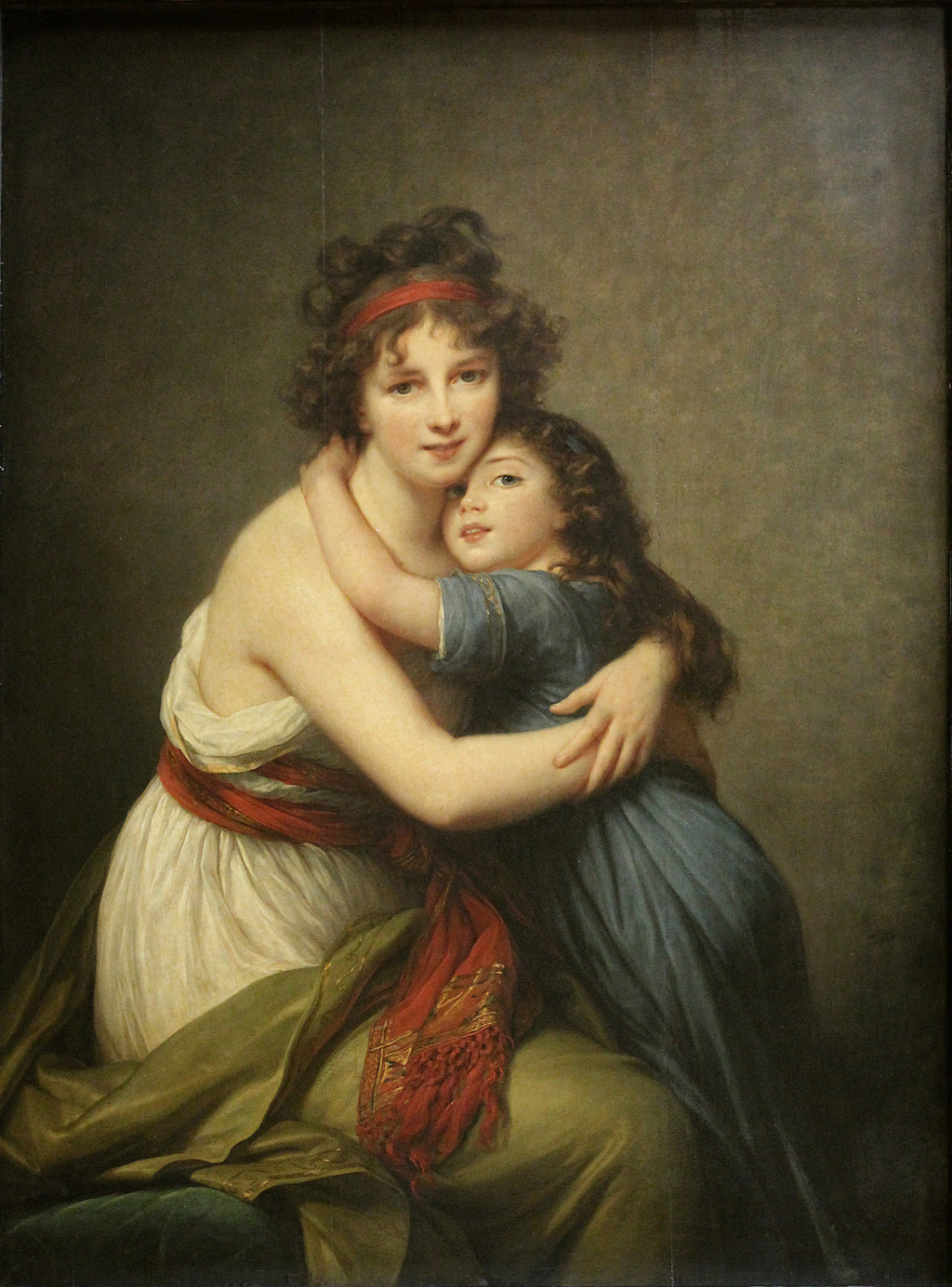
Mme Vigée Le Brun et sa fille, Jeanne-Lucie, dite Julie (1780-1819)
Elisabeth-Louise Vigée Le Brun
Huile sur toile, 1789
Musée du Louvre
Elle a tôt fermé fermé ses portes, au mois mars, mais se découvre dans le cadre d'une visite virtuelle sur le site du musée, ici : Petite Galerie, musée du Louvre
Vous y retrouverez l'un des autoportraits de l'artiste accompagnée de sa fille, accompagné de cette courte présentation :

Mme Vigée Le Brun et sa fille
Elisabeth-Louise Vigée Le Brun
Huile sur bois, 1786
Musée du Louvre
Image : RMN - Grand Palais (Musée du Louvre) / Franck Raux
Madame Vigée Le Brun et sa fille
Elisabeth-Louise Vigée Le Brun réalise cet autoportrait en compagnie de sa fille âgée de six ans en 1786, sujet qu’elle reprend en 1789 (Paris musée du Louvre, INV 3068).
L’artiste se représente, enlaçant Jeanne-Lucie dans un geste de protection et de tendresse maternelle, que le spectateur est invité, par le regard de l’enfant, à contempler. Si la scène relève de la sphère privée et de l’intime, elle s’inscrit dans le contexte de valorisation de l’enfant propre au 18e siècle. Jean-Jacques Rousseau a fait paraître L’Emile en 1762.
Au-delà de ses qualités à exprimer les sentiments, madame Vigée Le Brun s’affirme comme une artiste cultivée, s’inspirant dans son œuvre de l’attitude des Vierges à l’Enfant du peintre Raphaël (1483-1520), un des grands maîtres de la Renaissance italienne.
En choisissant d’exposer son autoportrait au Salon de 1787, elle montre ainsi son talent de portraitiste alors que les artistes femmes sont le plus souvent cantonnées dans le genre mineur de la nature morte. Elisabeth-Louise Vigée Le Brun fit une carrière remarquable : reçue académicienne en 1783, portraitiste de la reine Marie-Antoinette (1774-1793), son succès lui permit de s’émanciper de la tutelle masculine et de vivre de son art.

(…) elle s’est peinte tenant sa fille dans ses bras. La sérénité repose sur son front, la joie brille en ses yeux : elle triomphe de porter un si précieux fardeau et rend à son enfant tous les sourires qu’elle en reçoit. Une mignardise que réprouve également et les artistes et les amateurs et les gens de goût, dont il n’y a point d’exemple chez les anciens, c’est qu’en riant elle montre les dents, cette affectation est surtout déplacée dans une mère : elle ne compasse point de la sorte ses mouvements et se livre sans mesure à tout l’excès de son tendre enthousiasme *.
* Barthélemy Mouffle D’Angerville, Lettre I sur le Salon de 1787, dans Bachaumont, Les Salons de Bachaumont , Fabrice Faré ( ed), Paris, Librairie des Arts et métiers, 1995
* Source texte : Petite Galerie du musée du Louvre
Davantage d'informations sur le site internet L'Histoire par l'image qui précise, notamment :
En 1786, Élisabeth Louise Vigée Le Brun réalise un autoportrait avec sa fille, exposé au Salon de 1787. Le tableau touche à ce point le public par la véracité des sentiments représentés qu’il est rapidement surnommé La Tendresse maternelle.
Dans le sillage de ce succès et à la demande du comte d’Angiviller, directeur général des Bâtiments du Roi, l’artiste peint en 1789 une variante en costume grec tout aussi réputée.

Mme Vigée Le Brun et sa fille, Jeanne-Lucie, dite Julie (1780-1819)
Elisabeth-Louise Vigée Le Brun
Huile sur toile, 1789
Musée du Louvre

La nuit, la neige- Messages : 18131
Date d'inscription : 21/12/2013

Gouverneur Morris- Messages : 11795
Date d'inscription : 21/12/2013
 Re: Les autoportraits de Mme Vigée Le Brun
Re: Les autoportraits de Mme Vigée Le Brun
Merci pour cette jolie photo et ces informations complémentaires ! 
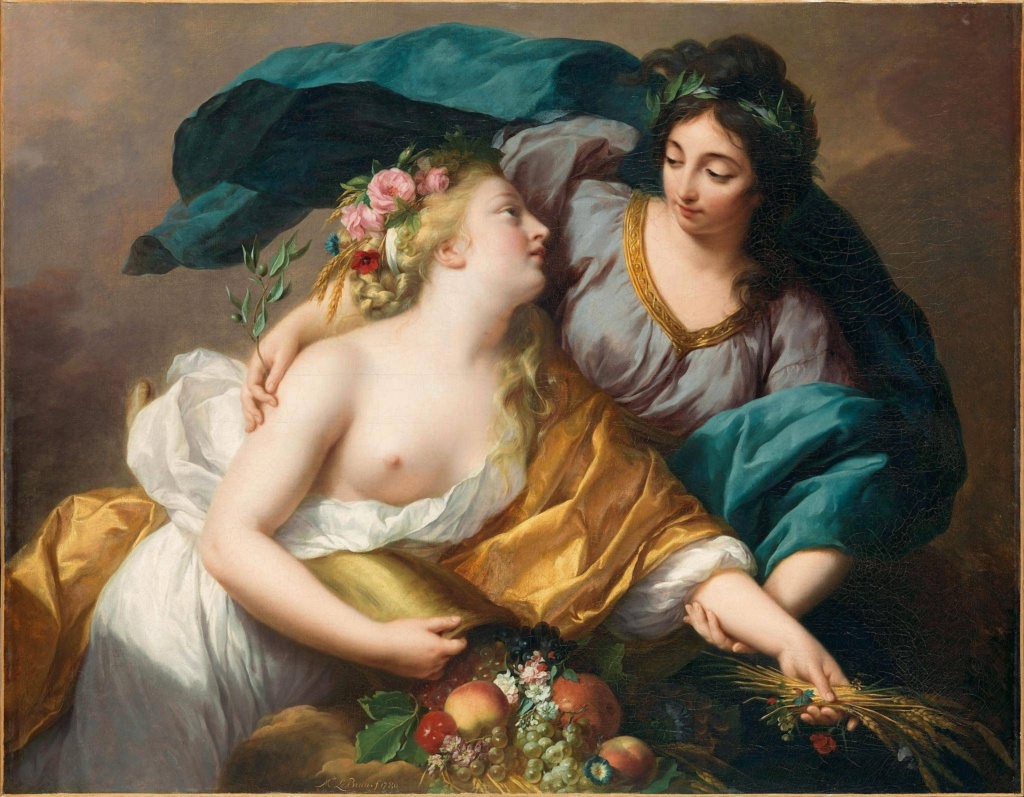
La Paix ramenant l’abondance
Élisabeth-Louise Vigée Le Brun
Huile sur toile, 1780
Salon de 1783
Image : RMN-Grand Palais / Philippe Fuzeau
 Voir notre sujet : Les collections de peintures du comte d'Artois à l'Hôtel du Grand Prieur, au Temple
Voir notre sujet : Les collections de peintures du comte d'Artois à l'Hôtel du Grand Prieur, au Temple
Gouverneur Morris a écrit:
On pouvait également y voir la plus ancienne oeuvre connue signée de son auteur, comme l'ont découvert récemment nos participants au jeu du printemps

La Paix ramenant l’abondance
Élisabeth-Louise Vigée Le Brun
Huile sur toile, 1780
Salon de 1783
Image : RMN-Grand Palais / Philippe Fuzeau

La nuit, la neige- Messages : 18131
Date d'inscription : 21/12/2013

Gouverneur Morris- Messages : 11795
Date d'inscription : 21/12/2013
 Re: Les autoportraits de Mme Vigée Le Brun
Re: Les autoportraits de Mme Vigée Le Brun
Un autoportrait bien connu de l'artiste qui sera prochainement proposé en vente aux enchères... 
Self-Portrait In Traveling Costume
Élisabeth Louise Vigée Le Brun
Paris 1755 - 1842
Pastel
bears inscription in black ink on the original backing: 28. novbre 1816 / Légué par Mr Menageot / à Mme Nigris-- / Ce dessin représente Mme Le Brun / il est fait par elle-même
19 ¾ by 15 ¾ in.; 480 by 375 mm (sight size)
Provenance :
Presented by the artist in Rome to François-Guillaume Ménageot (1744-1816); By bequest to Madame Gaétan Bernard Nigris, née Jeanne Louise “Julie” Le Brun (1780-1819); Presumably bequeathed by her to her cousin, Madame Justin Tripier Le Franc, née Eugénie Le Brun (1797-1872); Thence by inheritance to her son, Charles- Auguste Tripier Le Franc (1830-1892) (...)
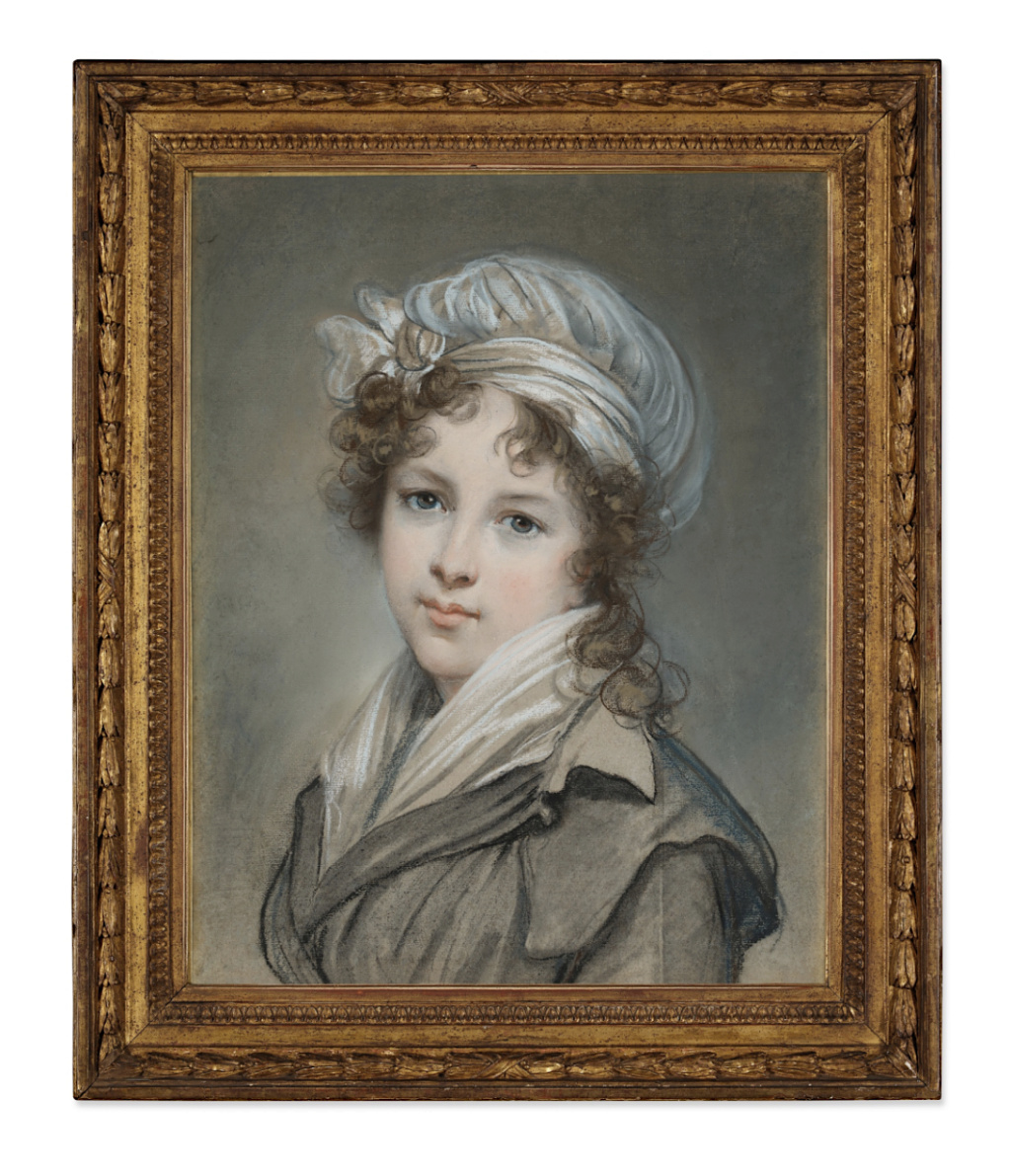
Lot Essay
This sensitively rendered yet visually striking self-portrait by Élisabeth Louise Vigée Le Brun was executed by the artist shortly after she had, with her nine-year-old daughter and the child’s governess, fled revolutionary Paris for Italy in the autumn of 1789. The French Revolution is a period of extraordinarily well-documented European history, and this is not the context in which to further elaborate, however suffice it to say Mme Le Brun’s proximity to the Maison de la Reine and various members of Marie Antoinette’s close circle made her at one moment the quasi-official painter of the Ancien Régime and in the next breath a political enemy of France.
Though the upheaval of Vigée Le Brun’s exile from her homeland was undoubtedly a time of profound insecurity and melancholy for the artist, these pressures clearly did nothing to negate her artistic genius. Indeed, the present work can be counted as one of, if not, the finest and most important pastels in her oeuvre. Executed in pastel on gray paper the artist portrays herself looking all of twenty – she was in fact thirty-four years old at the time she produced it – as she dons the simple clothing of a traveler in the form of a dress with a wide collar and short cape (a type of carrick), whilst her curly chestnut hair is bound into a muslin kerchief knotted at the top. It has been noted by Mary Tavener Holmes that “the modesty of the costume…adds to the naturalism and feeling of vitality” an observation that when coupled with the technical handling of the medium, in which “the chalk is often left unblended, adding to the sense of freshness and youth” (2) leaves the viewer simultaneously enthralled by the artists extraordinary artistic capacity as well as her legendary beauty.

With an artist as socially adept as Vigée Le Brun there can be little doubt that behind the technical accomplishments and aesthetic appeal of this pastel also lay a powerful political message for her detractors in France. Gone are the vestiges of extravagance or whimsy, traits which in much of her society and court portraits of women came to define her work as well as the era that was swept away by the Revolution, and were to be found in early self-portraits, such as Self-Portrait Wearing a Black Hat decorated with Cherry-Red Ribbons, (3) and the Self-Portrait in a Straw Hat, (4) as well as her numerous portrayals of Marie-Antoinette. Instead, in the words of Guégan “of the vanities of high society, she (Vigée Le Brun) has retained only the most elementary coquetry. Was there any better response than simplicity to the slanderous pamphlets targeting her on the eve of the Revolution?”. (5)

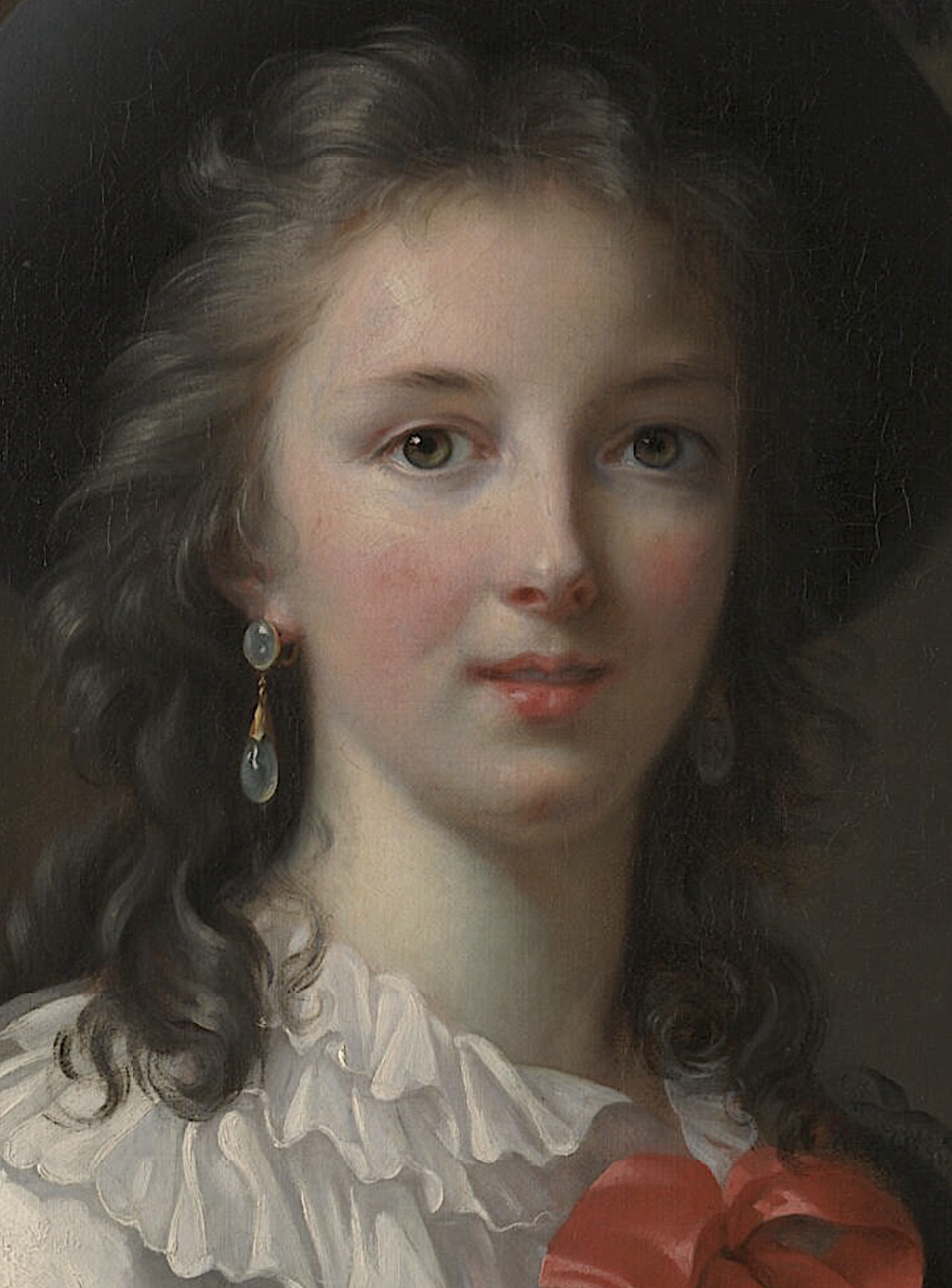
Self-Portrait Wearing a Black Hat decorated with Cherry-Red Ribbons
Elisabeth Louise Vigée Le Brun
Oil on canvas, c. 1781
Images : Kimbell Art Museum
Now many hundreds of miles from Paris and the ongoing recriminations of the French Revolution, Vigée Le Brun needed to provide herself and her daughter with some semblance of stability. She achieved this in part through the execution of two of her most celebrated self-portraits, the present work as well as her splendid Self-Portrait (6) commissioned by the Uffizi authorities following the artists visit to Florence. In mid-November 1789, just over a month after her departure from Paris, Mme Le Brun arrived in Italy and whilst enroute to Rome received authorization to visit the Palazzo Pitti and the Galleria degli Uffizi, in Florence.
There she was able to admire, amongst the many treasures, the collection of self-portraits first assembled by Prince Leopoldo de’ Medici from 1664 onward and was flattered when asked to add her own image to the prestigious assemblage. The Uffizi painting is an artistic tour de force and its initial reception was well documented by François-Guillaume Ménageot, the then Director of the Académie de France in Rome. According to Ménageot, “The painting Mme Le Brun has just finished is a complete success; with one voice, all of Rome is in awe of her talent and situates that portrait among the ranks of the most beautiful works”. (7)

Self-portrait
Elisabeth Louise Vigée Le Brun
Oil on canvas, c. 1790
Image : The Uffizi, Firenze
Ménageot is an interesting figure to quote regarding the Uffizi painting as his role within the broader context of Vigée Le Brun’s arrival in Italy was highly important and multifaceted. Firstly, in his capacity as Director of the Académie de France in Rome he was able to provide Vigée Le Brun with an apartment at the Palazzo Mancini in which she both lived and worked. This gesture of support was in some ways a reversal of roles for Ménageot and Mme Le Brun as in Paris, before taking up his post in Rome, the former had rented an apartment in the Hôtel de Lubert, the townhouse owned by Vigée Le Brun and her husband. `
Secondly and of particular interest and relevance to the present work, Ménageot was, in fact, its first owner having been presented it, per the old inscription to the original backing, by the artist. There has been some speculation surrounding the intention of this gift, with Guégan alluding to the “temptation to muse about the meaning of this token of affection” ( particularly considering the sitters more youthful appearance.
particularly considering the sitters more youthful appearance.
It seems likely, however, that the gift was made primarily out of gratitude for the way in which Ménageot supported Mme Le Brun and her family, upon her arrival in Rome. There can also be no doubt that there would have been little harm, as far as her artistic reputation was concerned, for the influential and well-connected Director of the Académie de France in Rome to be in possession of this virtuoso reminder, for any one in doubt, of what the artist was capable.


The appearance of this exquisite and rare work, presented for sale for the first time in over four decades, is a market defining moment for a work on paper by Vigée Le Brun. Its appearance comes some five years after the market for the artist’s work was redefined in these rooms by the sale of her monumental portrait of Muhammad Dervish Khan (9) and a decade since the last work on paper of major significance, Vigée Le Brun’s black chalk and stump Self-Portrait in a Straw Hat with a Plume, (10) appeared unexpectedly and with little fanfare at a small auction house in the suburbs of Paris.
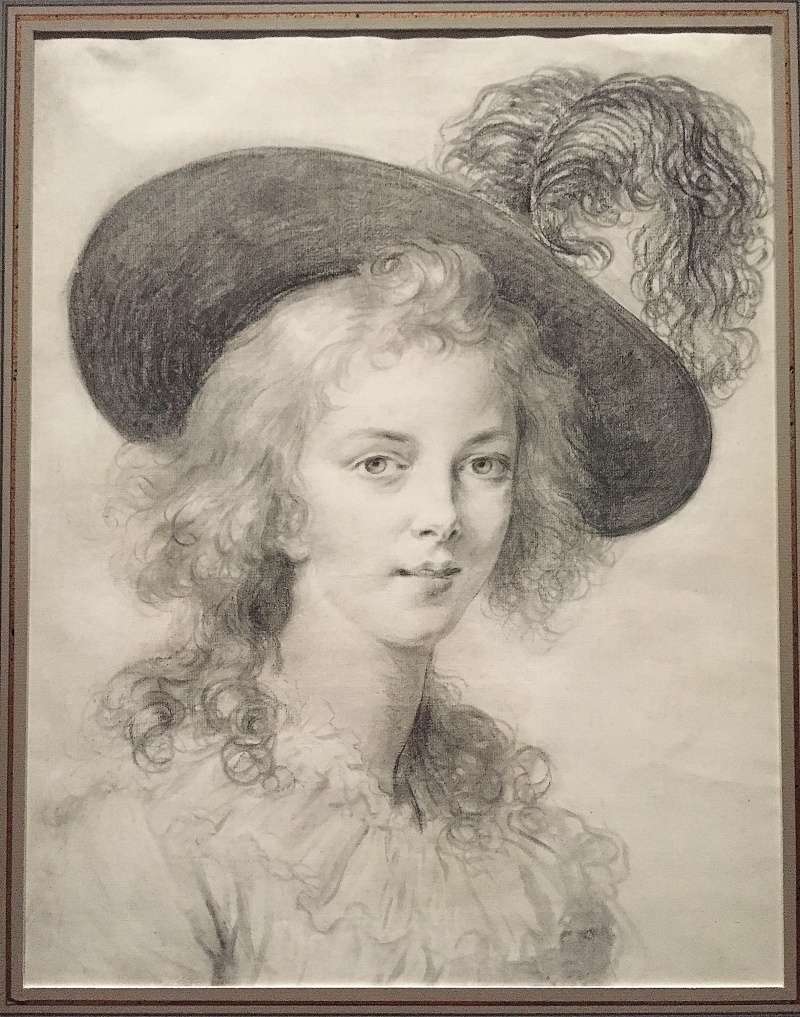
Self-Portrait in a Straw Hat with a Plume
Elisabeth Louise Vigée Le Brun
Black chalk, stumping, and charcoal on paper, c. 1783
Image : Forum Marie-Antoinette
Although it is easy, on occasion, for hyperbole to muddy our understanding of the importance of an object there is little risk of overstating things in the case of Self Portrait in Traveling Costume. It’s appearance on the market presents both private and institutional collectors alike with a unique opportunity to compete for that most rare of things, a true masterpiece, created at arguably the most fascinating and life defining moments of the artist’s career, that maintains through its utterly exquisite condition every semblance of quality and nuance that Vigée Le Brun first instilled in it over 230 years ago.
Notes :
1. J. Baillio and X. Salmon (eds.), Élisabeth Louise Vigée Le Brun, exhibition catalogue, Paris, Grand Palais, New York, Metropolitan Museum of Art, and Ottawa, Musée des Beaux-Arts du Canada, 2015-16, cat. no. 7
2. See New York, The Metropolitan Museum of Art, Eighteenth-Century French Drawings in New York Collections, New York 1999, p. 216
3. Baillio and Salmon, op. cit., p. 81, reproduced
4. Ibid., p. 11, reproduced
5. J. Baillio, K. Baetjer, and P. Lang, Élisabeth Louise Vigée Le Brun, exhibition catalogue, New York 2016, p. 139
6. Baillio and Salmon, op. cit., p. 143, reproduced
7. Correspondance des directeurs de l’Académie de France, vol. 15, p. 403, doc. 9065
8. Baillio and Salmon, op. cit., p. 139
9. J. Baillio and X. Salmon, Élisabeth Louise Vigée Le Brun, exhibition catalogue, Paris 2015, pp. 166-7, 352, cat. no. 53, reproduced p. 167; sale, New York, Sotheby’s, 30 January 2019, lot 38 ($7,185,900)
10. Baillio and Salmon, op. cit., p. 82, reproduced; Sale, Deuil-la-Barre, Hôtel des ventes de la Vallée de Montmorency, 11 March 2014, lot 16
* Source et infos complémentaires : Sotheby's - New York, vente du 31 janvier 2024
Self-Portrait In Traveling Costume
Élisabeth Louise Vigée Le Brun
Paris 1755 - 1842
Pastel
bears inscription in black ink on the original backing: 28. novbre 1816 / Légué par Mr Menageot / à Mme Nigris-- / Ce dessin représente Mme Le Brun / il est fait par elle-même
19 ¾ by 15 ¾ in.; 480 by 375 mm (sight size)
Provenance :
Presented by the artist in Rome to François-Guillaume Ménageot (1744-1816); By bequest to Madame Gaétan Bernard Nigris, née Jeanne Louise “Julie” Le Brun (1780-1819); Presumably bequeathed by her to her cousin, Madame Justin Tripier Le Franc, née Eugénie Le Brun (1797-1872); Thence by inheritance to her son, Charles- Auguste Tripier Le Franc (1830-1892) (...)

Lot Essay
This sensitively rendered yet visually striking self-portrait by Élisabeth Louise Vigée Le Brun was executed by the artist shortly after she had, with her nine-year-old daughter and the child’s governess, fled revolutionary Paris for Italy in the autumn of 1789. The French Revolution is a period of extraordinarily well-documented European history, and this is not the context in which to further elaborate, however suffice it to say Mme Le Brun’s proximity to the Maison de la Reine and various members of Marie Antoinette’s close circle made her at one moment the quasi-official painter of the Ancien Régime and in the next breath a political enemy of France.
Though the upheaval of Vigée Le Brun’s exile from her homeland was undoubtedly a time of profound insecurity and melancholy for the artist, these pressures clearly did nothing to negate her artistic genius. Indeed, the present work can be counted as one of, if not, the finest and most important pastels in her oeuvre. Executed in pastel on gray paper the artist portrays herself looking all of twenty – she was in fact thirty-four years old at the time she produced it – as she dons the simple clothing of a traveler in the form of a dress with a wide collar and short cape (a type of carrick), whilst her curly chestnut hair is bound into a muslin kerchief knotted at the top. It has been noted by Mary Tavener Holmes that “the modesty of the costume…adds to the naturalism and feeling of vitality” an observation that when coupled with the technical handling of the medium, in which “the chalk is often left unblended, adding to the sense of freshness and youth” (2) leaves the viewer simultaneously enthralled by the artists extraordinary artistic capacity as well as her legendary beauty.

With an artist as socially adept as Vigée Le Brun there can be little doubt that behind the technical accomplishments and aesthetic appeal of this pastel also lay a powerful political message for her detractors in France. Gone are the vestiges of extravagance or whimsy, traits which in much of her society and court portraits of women came to define her work as well as the era that was swept away by the Revolution, and were to be found in early self-portraits, such as Self-Portrait Wearing a Black Hat decorated with Cherry-Red Ribbons, (3) and the Self-Portrait in a Straw Hat, (4) as well as her numerous portrayals of Marie-Antoinette. Instead, in the words of Guégan “of the vanities of high society, she (Vigée Le Brun) has retained only the most elementary coquetry. Was there any better response than simplicity to the slanderous pamphlets targeting her on the eve of the Revolution?”. (5)


Self-Portrait Wearing a Black Hat decorated with Cherry-Red Ribbons
Elisabeth Louise Vigée Le Brun
Oil on canvas, c. 1781
Images : Kimbell Art Museum
Now many hundreds of miles from Paris and the ongoing recriminations of the French Revolution, Vigée Le Brun needed to provide herself and her daughter with some semblance of stability. She achieved this in part through the execution of two of her most celebrated self-portraits, the present work as well as her splendid Self-Portrait (6) commissioned by the Uffizi authorities following the artists visit to Florence. In mid-November 1789, just over a month after her departure from Paris, Mme Le Brun arrived in Italy and whilst enroute to Rome received authorization to visit the Palazzo Pitti and the Galleria degli Uffizi, in Florence.
There she was able to admire, amongst the many treasures, the collection of self-portraits first assembled by Prince Leopoldo de’ Medici from 1664 onward and was flattered when asked to add her own image to the prestigious assemblage. The Uffizi painting is an artistic tour de force and its initial reception was well documented by François-Guillaume Ménageot, the then Director of the Académie de France in Rome. According to Ménageot, “The painting Mme Le Brun has just finished is a complete success; with one voice, all of Rome is in awe of her talent and situates that portrait among the ranks of the most beautiful works”. (7)

Self-portrait
Elisabeth Louise Vigée Le Brun
Oil on canvas, c. 1790
Image : The Uffizi, Firenze
Ménageot is an interesting figure to quote regarding the Uffizi painting as his role within the broader context of Vigée Le Brun’s arrival in Italy was highly important and multifaceted. Firstly, in his capacity as Director of the Académie de France in Rome he was able to provide Vigée Le Brun with an apartment at the Palazzo Mancini in which she both lived and worked. This gesture of support was in some ways a reversal of roles for Ménageot and Mme Le Brun as in Paris, before taking up his post in Rome, the former had rented an apartment in the Hôtel de Lubert, the townhouse owned by Vigée Le Brun and her husband. `
Secondly and of particular interest and relevance to the present work, Ménageot was, in fact, its first owner having been presented it, per the old inscription to the original backing, by the artist. There has been some speculation surrounding the intention of this gift, with Guégan alluding to the “temptation to muse about the meaning of this token of affection” (
It seems likely, however, that the gift was made primarily out of gratitude for the way in which Ménageot supported Mme Le Brun and her family, upon her arrival in Rome. There can also be no doubt that there would have been little harm, as far as her artistic reputation was concerned, for the influential and well-connected Director of the Académie de France in Rome to be in possession of this virtuoso reminder, for any one in doubt, of what the artist was capable.


The appearance of this exquisite and rare work, presented for sale for the first time in over four decades, is a market defining moment for a work on paper by Vigée Le Brun. Its appearance comes some five years after the market for the artist’s work was redefined in these rooms by the sale of her monumental portrait of Muhammad Dervish Khan (9) and a decade since the last work on paper of major significance, Vigée Le Brun’s black chalk and stump Self-Portrait in a Straw Hat with a Plume, (10) appeared unexpectedly and with little fanfare at a small auction house in the suburbs of Paris.

Self-Portrait in a Straw Hat with a Plume
Elisabeth Louise Vigée Le Brun
Black chalk, stumping, and charcoal on paper, c. 1783
Image : Forum Marie-Antoinette
Although it is easy, on occasion, for hyperbole to muddy our understanding of the importance of an object there is little risk of overstating things in the case of Self Portrait in Traveling Costume. It’s appearance on the market presents both private and institutional collectors alike with a unique opportunity to compete for that most rare of things, a true masterpiece, created at arguably the most fascinating and life defining moments of the artist’s career, that maintains through its utterly exquisite condition every semblance of quality and nuance that Vigée Le Brun first instilled in it over 230 years ago.
Notes :
1. J. Baillio and X. Salmon (eds.), Élisabeth Louise Vigée Le Brun, exhibition catalogue, Paris, Grand Palais, New York, Metropolitan Museum of Art, and Ottawa, Musée des Beaux-Arts du Canada, 2015-16, cat. no. 7
2. See New York, The Metropolitan Museum of Art, Eighteenth-Century French Drawings in New York Collections, New York 1999, p. 216
3. Baillio and Salmon, op. cit., p. 81, reproduced
4. Ibid., p. 11, reproduced
5. J. Baillio, K. Baetjer, and P. Lang, Élisabeth Louise Vigée Le Brun, exhibition catalogue, New York 2016, p. 139
6. Baillio and Salmon, op. cit., p. 143, reproduced
7. Correspondance des directeurs de l’Académie de France, vol. 15, p. 403, doc. 9065
8. Baillio and Salmon, op. cit., p. 139
9. J. Baillio and X. Salmon, Élisabeth Louise Vigée Le Brun, exhibition catalogue, Paris 2015, pp. 166-7, 352, cat. no. 53, reproduced p. 167; sale, New York, Sotheby’s, 30 January 2019, lot 38 ($7,185,900)
10. Baillio and Salmon, op. cit., p. 82, reproduced; Sale, Deuil-la-Barre, Hôtel des ventes de la Vallée de Montmorency, 11 March 2014, lot 16
* Source et infos complémentaires : Sotheby's - New York, vente du 31 janvier 2024

La nuit, la neige- Messages : 18131
Date d'inscription : 21/12/2013
 Re: Les autoportraits de Mme Vigée Le Brun
Re: Les autoportraits de Mme Vigée Le Brun
Voici annoncé en vente aux enchères prochainement...
Portrait of Élisabeth Louise Vigée Le Brun with Cerise Ribbons
Circle of Élisabeth Louise Vigée Le Brun
oil on canvas
canvas: 24 by 19 ⅞ in.; 61.0 by 50.5 cm.
framed: 32 by 28 in.; 81.3 by 71.1 cm
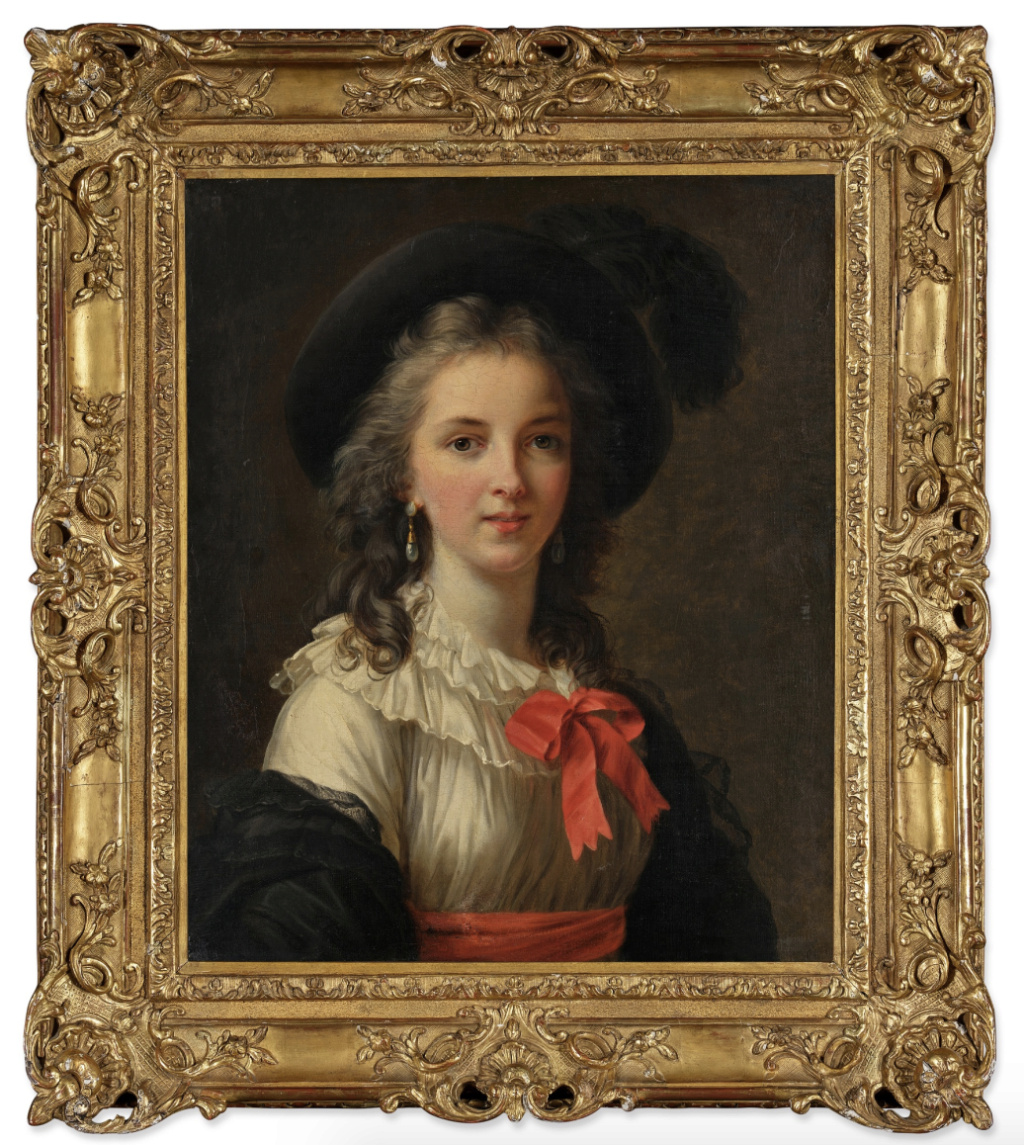


Lot Essay
Que dalle pour la version du catalogue en ligne.
 Je vous renvoie donc à nos précédents commentaires.
Je vous renvoie donc à nos précédents commentaires.
* Source et infos complémentaires : Sotheby's - New York, vente du 1er février 2024
 Nous évoquions tout récemment (message précédent) le portrait original conservé au Kimbell Art Museum, sur les images, à droite, pour la comparaison :
Nous évoquions tout récemment (message précédent) le portrait original conservé au Kimbell Art Museum, sur les images, à droite, pour la comparaison :

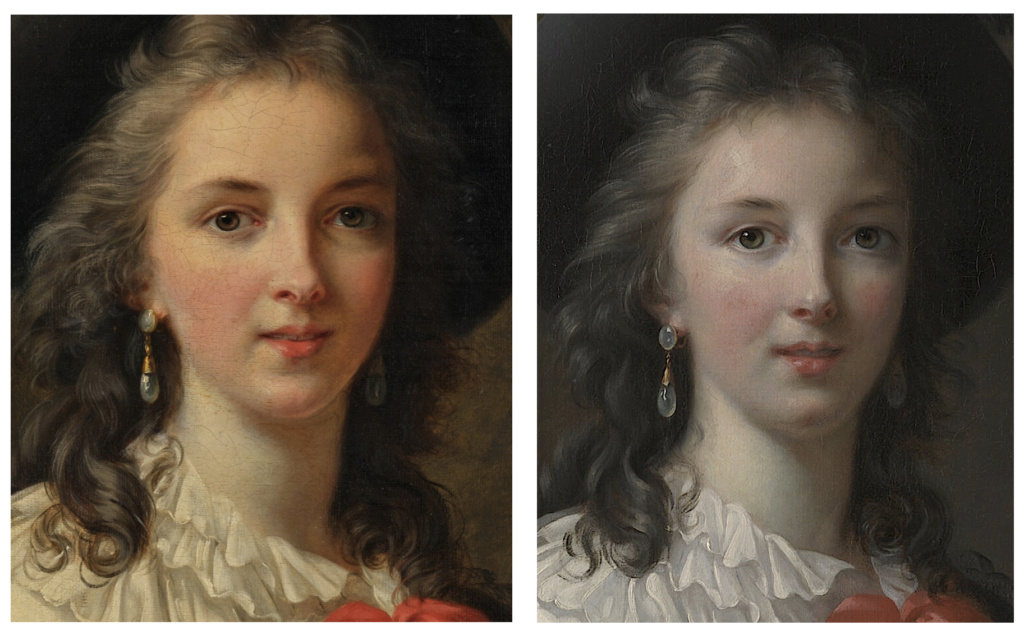
Portrait of Élisabeth Louise Vigée Le Brun with Cerise Ribbons
Circle of Élisabeth Louise Vigée Le Brun
oil on canvas
canvas: 24 by 19 ⅞ in.; 61.0 by 50.5 cm.
framed: 32 by 28 in.; 81.3 by 71.1 cm



Lot Essay
Que dalle pour la version du catalogue en ligne.

 Je vous renvoie donc à nos précédents commentaires.
Je vous renvoie donc à nos précédents commentaires. * Source et infos complémentaires : Sotheby's - New York, vente du 1er février 2024
________________________



La nuit, la neige- Messages : 18131
Date d'inscription : 21/12/2013
Page 3 sur 3 •  1, 2, 3
1, 2, 3
 Sujets similaires
Sujets similaires» Signature d'Elisabeth Vigée Le Brun
» Louise-Elisabeth Vigée Le Brun
» Docu-fiction : Le fabuleux destin d'Elisabeth Vigee Le Brun, peintre de Marie-Antoinette (2015)
» Portraits de la duchesse de Polignac
» Galerie virtuelle des oeuvres de Mme Vigée Le Brun
» Louise-Elisabeth Vigée Le Brun
» Docu-fiction : Le fabuleux destin d'Elisabeth Vigee Le Brun, peintre de Marie-Antoinette (2015)
» Portraits de la duchesse de Polignac
» Galerie virtuelle des oeuvres de Mme Vigée Le Brun
LE FORUM DE MARIE-ANTOINETTE :: La France et le Monde au XVIIIe siècle :: Les Arts et l'artisanat au XVIIIe siècle :: Les arts graphiques et la sculpture
Page 3 sur 3
Permission de ce forum:
Vous ne pouvez pas répondre aux sujets dans ce forum




